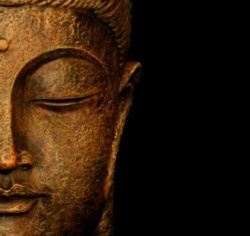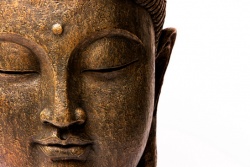Subitism
The term Subitism points to sudden Enlightenment in Buddhism, the idea that insight into the True Nature or emptiness of the self is all at once.
Origin
Illumination subite
The application of the term to Buddhism is derived from the French illumination subite (sudden awakening), contrasting with 'illumination graduelle' (gradual awakening). It gained currency in this use in English from the work of sinologist Paul Demiéville. His 1947 work 'Mirror of the Mind' was widely read in the U.S. It inaugurated a series by him on subitism and gradualism.
Vipassana and Samatha
The distinction between sudden and gradual may be traced back to the differentiation between vipassana and Samatha in the earliest doctrinal disputes in Buddhism. According to Gombrich, the distinction between vipassana and Samatha did not originate in the suttas, but in the interpretation of the suttas. In the suttas are traces of ancient debates about the interpretation of the teachings, and early classifications and hierarchies. Out of these debates developed the idea that bare insight suffices to reach liberation, by bare insight alone in the Three marks of existence, namely Dukkha, Anatta and anicca. This is in contradiction with the Four Noble Truths and the Noble Eightfold Path, in which the Buddhist path starts with insight, to be followed by practices to cultivate the mind and reach Nirvana.
The emphasis on insight is also discernible in the Mahayana-tradition, which emphasises Prajna:
- [T]he very title of of a large corpus of early Mahayana literature, the Prajnaparamita, shows that to some extent the historian may extrapolate the trend to extol insight, Prajna, at the expense of dispassion, viraga, the control of the emotions.
Although Theravada and Mahayana are commonly understood as different streams of Buddhism, their practice too may reflect emphasis on insight as a common denominator:
- In practice and understanding Zen is actually very close to the Theravada Forest Tradition even though its language and teachings are heavily influenced by Taoism and Confucianism.
Chinese Buddhism
The distinction between sudden and gradual awakening was first introduced in China in the beginning of the 5th century CE by Tao Sheng.
Chán
The term is used in Ch'an and Zen discourse to denote the doctrinal position that awakening or Enlightenment (Kensho, Bodhi or Satori) is instantaneous, sudden and direct, not attained by practice through a period of time, and not the fruit of a gradual accretion or realisation. Aspects of Dzogchen and Mahamudra may be referred to as subitist, as well as the Rinzai school.
Huineng
In the 8th century it became part of a struggle for influence at the Chinese court by Shenhui, a student of Huineng. Here-after "sudden Enlightenment" became one of the hallmarks of Chinese Chán, though the sharp distinction was softened by subsequent generations of Zen-practitioners.
This softening is reflected in The Platform Sutra, a text ascribed to Hui Neng, but composed by later writers of various schools.
- While the Patriarch was living in Bao Lin Monastery, the Grand Master Shen Xiu was preaching in Yu Quan Monastery of Jing Nan. At that time the two Schools, that of Hui Neng of the South and Shen Xiu of the North, flourished side by side. As the two Schools were distinguished from each other by the names "Sudden" (the South) and "Gradual" (the North), the question which sect they should follow baffled certain Buddhist scholars (of that time). (Seeing this), the Patriarch addressed the assembly as follows:
- So far as the Dharma is concerned, there can be only one School. (If a distinction exists) it exists in the fact that the founder of one school is a northern man, while the other is a southerner. While there is only one Dharma, some disciples realize it more quickly than others. The reason why the names 'Sudden' and 'Gradual' are given is that some disciples are superior to others in mental dispositions. So far as the Dharma is concerned, the distinction of 'Sudden' and 'Gradual' does not exist.
Later interpretations
Guifeng Zongmi, fifth-generation successor to Shenhui, also softened the edge between sudden and gradual. In his analysis, sudden awakening points to seeing into one's true nature, but is to be followed by a gradual cultivation to attain Buddhahood.
This is also the standpoint of the contemporary Sanbo Kyodan, according to whom Kensho is at the start of the path to full Enlightenment.
This gradual cultivation is also recognized by Tozan, who described the Five ranks of Enlightenment. Other example of depiction of stages on the path are the Ten Ox-Herding Pictures which detail the steps on the Path, The Three mysterious Gates of Linji, and the Four Ways of Knowing of Hakuin. This gradual cultivation is described by Chan Master Sheng Yen as follows:
- Ch'an expressions refer to Enlightenment as "seeing your self-nature". But even this is not enough. After seeing your self-nature, you need to deepen your experience even further and bring it into maturation. You should have Enlightenment experience again and again and support them with continuous practice. Even though Ch'an says that at the time of Enlightenment, your outlook is the same as of The Buddha, you are not yet a full Buddha.
Rivalry between schools
When the so-called Southern School placed emphasis on sudden Enlightenment, it also marked a shift in doctrinal basis from the Lankavatara-Sutra to the prajnaparamita-tradition, especially The Diamond Sutra. The Lankavatara-Sutra, which endorses the Buddha-nature, emphasized purity of mind, which can be attained in gradations. The Diamond-Sutra emphasizes Sunyata, which "must be realized totally or not at all".
Once this dichotomy was in place, it defined its own logic and rhetorics, which are also recognizable in the distinction between Caodong (Soto) and Lin-ji (Rinzai) chán. But it also leads to a "sometimes bitter and always prolix sectarian controversy between later Chán and Hua-yen exegetes". In the Huayan classification of teachings, the sudden approach was regarded inferior to the Perfect Teaching of Hua-yen. Guifeng Zongmi, fifth patriarch of Hua-yen ànd Chán-master, deviced his own classification to counter this subordination. To establish the superiority of the Chán-teachings, Chinul explained the sudden approach as not pointing to mere emptiness, but to suchness or the dharmadhatu.
Hua-yen
In the Fivefold Classification of the Huayan school and the Five Periods and Eight Teachings of the Tiantai-school the sudden teaching was given a high place, but still inferior to the Complete or Perfect teachings of these schools.
Korean Seon
Chinul, a 12th-century Korean Seon master, followed Zongmi, and also emphasized that insight into our true nature is sudden, but is to be followed by practice to ripen the insight and attain full Buddhahood.
In contemporary Korean Seon, Seongcheol has defended the stance of "sudden insight, sudden cultivation". Citing Taego Bou (太古普愚: 1301-1382) as the true successor of the Linji Yixuan (臨済義玄) line of patriarchs rather than Jinul (知訥: 1158-1210), he advocated Hui Neng's original stance of 'sudden Enlightenment, sudden cultivation' (Hangul: 돈오돈수, Hanja: 頓悟頓修) as opposed to Jinul's stance of 'sudden Enlightenment, gradual cultivation' (Hangul: 돈오점수, Hanja: 頓悟漸修). Whereas Jinul had initially asserted that with Enlightenment comes the need to further one's practice by gradually destroying the karmic vestiges attained through millions of rebirths, Huineng and Seongcheol maintained that with perfect Enlightenment, all karmic remnants disappear and one becomes a Buddha immediately.



